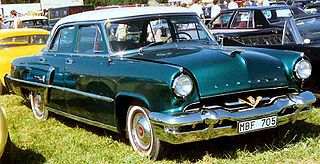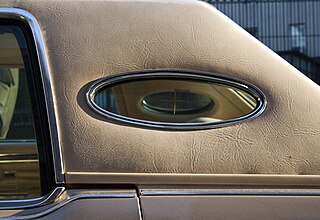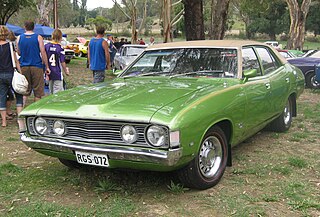
The Ford Thunderbird is a personal luxury car manufactured and marketed by Ford Motor Company from model years 1955 to 2005, across 11 generations. Introduced as a two-seat convertible, the Thunderbird was offered variously as a four-seat hardtop coupe, four-seat convertible, five-seat convertible and hardtop, four-door pillared hardtop sedan, six-passenger hardtop coupe, and five-passenger pillared coupe, with the final generation designed again as a two-seat convertible.

The Ford Galaxie is a car that was marketed by Ford in North America from the 1959 to 1974 model years. Deriving its nameplate from a marketing tie-in with the excitement surrounding the Space Race, the Galaxie was offered as a sedan within the full-size Ford range throughout its production run. In the full-size segment, the model line competed against the Chevrolet Impala and Dodge Polara.

The Ford Falcon is a full-size car that was manufactured by Ford Australia from 1960 to 2016. From the XA series of 1972 onward, each Falcon and range of derivates have been designed, developed, and built in Australia, following the phasing out of the American-influenced Falcon of 1960 to 1971, which had been re-engineered locally as the XK to XY series for the harsher Australian conditions. The luxury-oriented Ford Fairmont model joined the range from 1965. Luxury long-wheelbase derivative versions called the Ford Fairlane and LTD arrived in 1967 and 1973 respectively with production ending in 2007.

The Mercury Cougar is a series of automobiles that was sold by Mercury from 1967 to 2002. The model line is a diverse series of vehicles; though the Cougar nameplate is most commonly associated with two-door coupes, at various stages in its production, the model also was offered as a convertible and a hatchback. During its production as the mid-size Mercury line, the Cougar was also offered as a four-door sedan and five-door station wagon.

The Ford Fairmont is a model line of compact cars that was manufactured by Ford from the 1978 to 1983 model years. The successor of the Ford Maverick, the Fairmont marked the third generation of compact sedans sold by Ford in North America. Initially slotted between the Pinto and Granada within the Ford line, the Fairmont was later marketed between the Ford Escort and Ford LTD. In contrast to its predecessor, the model line was offered as a two-door notchback sedan, two-door coupe, four-door sedan, and five-door station wagon. Though never sold as a Lincoln, Mercury sold a divisional counterpart of the Fairmont as the Mercury Zephyr.

The Ford LTD is a range of automobiles manufactured by Ford for the 1965 to 1986 model years. Introduced as the highest trim level of the full-size Ford model range, the LTD moved the Ford range upmarket, offering options and features previously reserved for Mercury and Lincoln vehicles. For much of its production life, the LTD competed against the Chevrolet Caprice ; the Mercury Marquis served as its divisional counterpart from 1967 until 1986.

The Ford Fairlane is an automobile model that was sold between the 1955 and 1970 model years by Ford in North America. Taking its name from the Dearborn, Michigan estate of Henry Ford, the Fairlane nameplate was used for seven different generations of vehicles. Through its production, the model line would be marketed in a wide variety of body styles, including two-door and four-door sedans, two-door and four-door hardtops, station wagons, and both traditional and retractable-hardtop convertibles.

The Ford Fairlane and LTD are full-sized luxury vehicles produced in a series of models by Ford Australia between 1959 and 2007.

The Mercury Marquis is a model line of automobiles marketed by Mercury from 1967 to 1986. Deriving its name from a title of French nobility, the Marquis was introduced as the divisional counterpart of the Ford LTD; four generations of the two model lines were paired through rebranding. Initially slotted as the flagship Mercury full-size range, the Marquis would serve as the basis for the later Mercury Grand Marquis.

The Lincoln Premiere was a luxury car model sold by Lincoln in the 1956 to 1960 model years. Positioned below the company's Continental Mark II coupe during 1956–1957 and above the Capri which it shared from 1956 to 1959, it was produced in 2 and 4 door versions which could both accommodate up to six people.

The Lincoln Capri is an automobile that was sold by the Lincoln division of Ford Motor Company from 1952 until 1959. A full-size luxury car, the Lincoln Capri derives its name from an Italian island in the Gulf of Naples. Positioned as a premium trim variant of the two-door Lincoln Cosmopolitan, the Capri was introduced in 1952 as a stand-alone model line serving as the premium Lincoln. With the introduction of the Lincoln Premiere, the Capri replaced the Cosmopolitan as the standard Lincoln product line.

The Ford Falcon is a model line of cars that was produced by Ford from the 1960 to 1970 model years. Though preceded by the Rambler American, the Falcon was the first compact car marketed by the Big Three American manufacturers.

An opera window is a small fixed window usually behind the rear side window of an automobile. They are typically mounted in the C-pillar of some cars. The design feature was popular during the 1970s and early 1980s and adopted by domestic U.S. manufacturers, most often with a vinyl roof.

The Ford Fairmont is a full-size car that was built by Ford Australia as an upmarket model of the Ford Falcon from 1965 to 2008. It featured a higher level of standard equipment than corresponding Falcon models of the same series. As well as offering a more luxurious interior trim with additional comfort and convenience features, for much of its first 25 years the Fairmont also offered a higher mechanical specification; a larger capacity engine and refinements such as disc brakes, power steering and automatic transmission that were extra cost options for the Falcon were fitted as standard equipment for the Fairmont. It was available as a four-door sedan throughout its life, as a five-door station wagon from its introduction through to 2002, and as a two-door hardtop from 1972 to 1978.

The Ford Falcon (XA) is a full-size car that was produced by Ford Australia from 1972 to 1973. It was the first iteration of the third generation of the Falcon and also included the Ford Fairmont (XA)—the luxury-oriented version. The XA platform was also used for the Australian Ford Landau.

The Ford Falcon (XB) is a full-size car that was produced by Ford Australia from 1973 to 1976. It was the second iteration of the third generation of the Falcon and also included the Ford Fairmont (XB), the luxury-oriented version.

The Ford Falcon (XC) is a full-size car that was produced by Ford Australia from 1976 to 1979. It was the third and last iteration of the third generation of the Falcon and also included the Ford Fairmont (XC)—the luxury-oriented version of the Falcon.

The first-generation Ford Mustang was manufactured by Ford from March 1964 until 1973. The introduction of the Mustang created a new class of automobiles known as pony cars. The Mustang's styling, with its long hood and short deck, proved wildly popular and inspired a host of competition.

The Ford Falcon GT is an automobile produced by Ford Australia from 1967 until 1976 as the performance version of its Falcon model range. Its production was resumed by a joint venture in 1992 and 1997 with Tickford, and then again between 2003 and 2014 with Prodrive, the latter being marketed as the FPV GT & GT-P. The Falcon GT is inextricably linked with the history of Australian sports sedan car production and with the evolution of Australian motor racing.The Falcon GT lineage includes many Bathurst wins and motorsport accolades over its entire production run.

The eighth generation of the Ford Thunderbird is a personal luxury coupe that was manufactured and marketed by Ford from the 1980 to 1982 model years. Introduced to commemorate the 25th year of the Thunderbird, the eighth generation was substantially downsized, transitioning further into the mid-size segment. For a second generation, the Thunderbird remained the Ford counterpart of the Mercury Cougar XR7; while the Cougar again served as a complete line of mid-sized cars in various body styles starting with 1981 models, the Thunderbird was offered solely as a two-door personal luxury coupe.
























